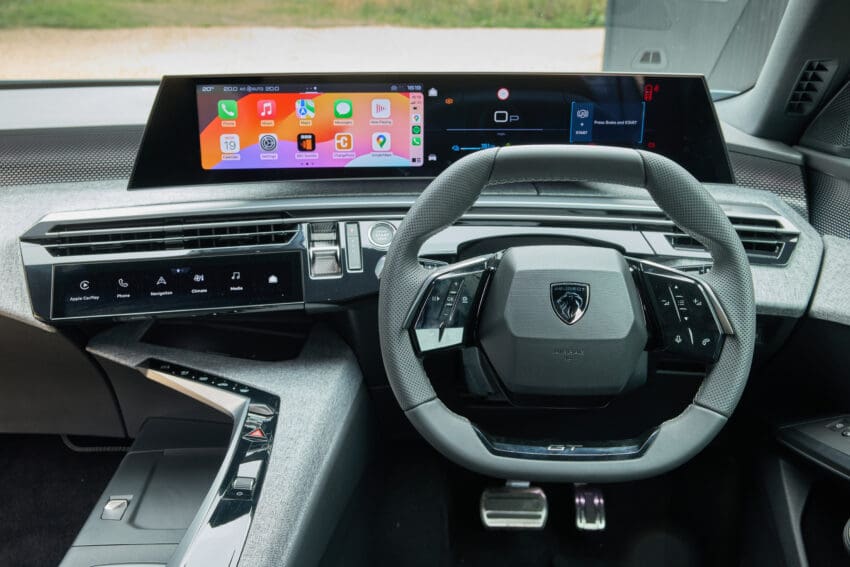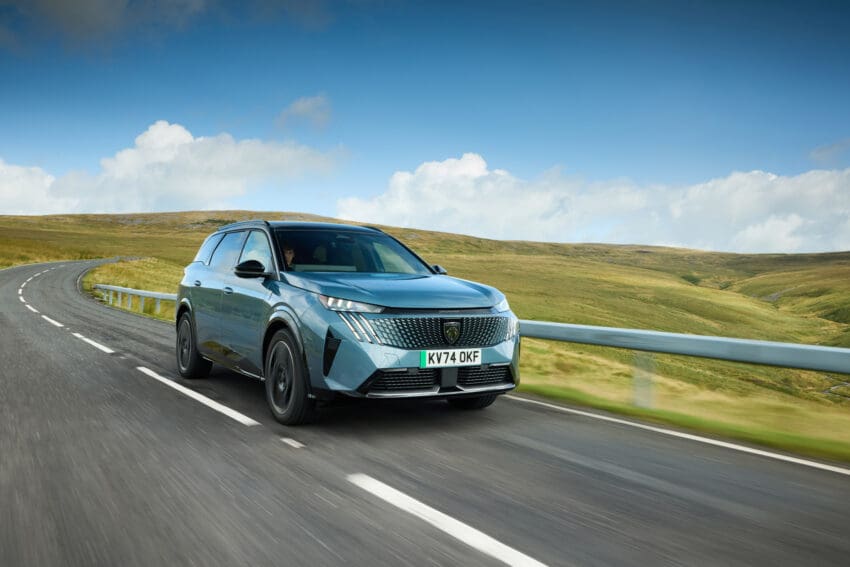Peugeot E-5008 review: Is this the electric seven-seater sweet spot?
We test the Peugeot E-5008 to see how well it fills the mainstream gap between basic van-based MPVs and premium-priced SUVs
The market for seven-seat electric cars hasn’t been huge in recent years.
We’ve had a few van-based options and the disappointing Mercedes EQB but the mainstream SUV offering has been noticeably slim.
The first real effort was last year’s Kia EV9 and even that stretches the idea of mainstream to breaking point, which means that the Peugeot E-5008 might just be able to carve itself out a nice little niche.
It’s smaller and cheaper than the Kia but, like the previous 5008, claims to offer family-friendly motoring for up to seven people plus a class-leading electric range.
Design, interior and technology
The 5008 isn’t the most handsome Peugeot on sale but it does a decent job of bringing the brand’s angular design to a fairly large and boxy body.
The slab sides and tall upright rear are very similar to the previous generation but at the front there’s a very similar look to the smaller E-3008, with triple-stripe lighting and a massive body-coloured textured grille.
Electric versions of the 5008 are identifiable from their hybrid siblings thanks to some funky alloys and gloss black body trim around the wheel arches and door sills.
At 4.79m long and 1.89m wide, it’s smaller than the gargantuan EV9, but bigger than the EQB. That means it’s a bit easier to manoeuvre around while still offering a usable seven-seat interior.
Inside, everything follows the current Peugeot design trend. That means you get a fresh, modern look with some interesting materials and a brave driver-focused dashboard and centre console.
Twin screens float above the dash and are lit from underneath by a textured LED panel that runs the width of the dash and continues into the front and rear doors. The floating screens create a feeling of airiness that’s enhanced by the pale grey fabric on the dashboard and door tops. For the first time, this also features across the shoulders of the front seats to carry the look into the rear part of the cabin.

In row two, the new 5008 model ditches the three individual seats in favour of a more familiar 60/40 split bench. This feels like a backwards step, and the middle seat is distinctly less spacious than before. It does mean the more-frequently-used outer ones get more space but slightly dents the image as a proper seven-seater. You can, nonetheless, fold the middle seatback down individually to create an armrest or load-through space from the boot.
In that boot, you’ll find the rearmost two seats which fold up and down with the pull of a fabric tab and collapse into the boot floor when not in use to create a totally flat surface. Cleverly, there’s a small board that forms the very rear of the boot floor and which conceals an extra 80-litre storage space beneath those seats.
The Peugeot’s rearmost row is definitely tighter than the EV9’s, reflecting its smaller stature. While the Kia can accommodate an average adult, the Peugeot’s seats are really only for children, and even with the middle bench slid forward, there’s not a huge amount of knee or foot room. There also are’t air vents or charging ports – both of which are standard on the more expensive Kia.
In seven-seat configuration, the boot is a decent 348 litres (including that underfloor space), which rises to 916 litres in five-seat mode – plenty for all sorts of lifestyle accoutrements. For reference, an EV9 manages 333 litres and 828 litres, and the van-based Peugeot E-Rifter 209/1,050 litres.
Back up front, the E-5008 features the same infotainment system as the E-3008, including the iToggles – a configurable shortcut panel in the centre console. That proves useful as the main operating system sometimes feels cluttered and badly laid out, so quick keys for features such as climate and ADAS settings are a real help.
Battery, motor and performance
For the moment, the E-5008 comes with a single powertrain, although more are on the way.
The 207bhp motor and 73kWh battery are shared with the smaller E-3008 and the E-5008’s extra size shows on the road, where performance is a little dull.
There’s an initial willingness and it’s sufficiently punchy for motoring around town but accelerate from urban to national speed limits and you feel the limitations of the single-motor setup. It’s perfectly adequate (and more than the plug-in hybrid model gets) but if you want your 5008 with more punch, a two-motor 316bhp version will be along in 2025.
Regardless of outright pace, the E-5008 drives perfectly well for what it is. No-one buys a seven-seat SUV for the thrills. Buyers want secure, solid and composed and the 5008 nails two of those, even if the latter is a little patchy. The small steering wheel lends a speediness to the steering that alternatives can’t match but normal mode is a touch on the light side while sport feels artificially heavy. Body control is actually pretty impressive for such a tall vehicle but the ride wavers between controlled and harsh. Refinement elsewhere is far better, with excellent noise suppression that is on par with far more expensive premium models.
Peugeot is claiming a bit of a coup with the E-5008 which, from October, will offer the longest range in its class. A 96.9kWh battery will allow the two-wheel-drive car to cover up to 415 miles on the WLTP cycle. That’s 66 miles more than the RWD Kia EV9 or 14 miles more than the current segment leader – the £130,000 Mercedes EQS.
Until then, the E-5008 comes with the same 73kWh battery as the E-3008 and offers a range of 311 miles – that’s 38 miles down on the rear-wheel-drive EV9 but on a par with the twin-motor version. Test drive routes aren’t always the best for judging a car’s efficiency and our route featured some painfully slow sections but on a varied collection of roads my test car managed a creditable 3.7m/kWh, impressive for such a large car.
Like other electric Peugeots, the E-5008 charges at up to 160kW, meaning a 20-80% charge takes half an hour.
Price and specification
The Peugeot E-5008 is priced from £48,550. That is not a million miles away from the smaller 3008, creating an interesting choice for buyers. You can get a lot more space and practicality in the E-5008 with very little sacrifice in range or performance for a couple of thousand pounds more, making it a more appealing prospect.
Even in the most expensive GT trim, the two-wheel-drive is £52,350. That’s not cheap but considering that the EV9 starts at £65,000 and a Volvo EX90 is £100,000, it makes the Peugeot a more accessible option.
All models come with 19-inch alloys, LED lights and the 21-inch dual screen array. Wireless phone mirroring and charging, keyless entry, part-vegan leather upholstery and three-zone climate control are also standard. GT trim adds heated seats and steering wheel, a powered tailgate, adaptive LED lights and adaptive cruise control as well as 20-inch wheels and widened wheel arches for a more aggressive look. However, a panoramic roof is £950 extra and a heat pump is a £700 option.
Verdict
In absolute terms, the Peugeot E-5008 isn’t the best seven-seat SUV on the market. That accolade has to go to the Kia EV9, which offers a larger, more comfortable and practical interior as well as some advantages in equipment and charging speed.
But the Peugeot is £17,000 cheaper. That buys you a lot of leeway, especially in a segment that’s largely torn between compromised van-based vehicles with short ranges and £100,000 super-SUVs from premium brands.
It brings plenty of practicality and capability, all the modern touches a family needs and (soon) the promise of a range similar to that of a petrol-powered equivalent.
Peugeot E-5008 GT
- Price: £52,350
- Powertrain: single-motor, front-wheel-drive
- Battery: 73kWh
- Power: 207bhp
- Torque: 254lb ft
- Top speed: 105mph
- 0-62mph: 9.7 seconds
- Range: 311 miles
- Consumption: 3.6m/kWh
- Charging: up to 160kW

